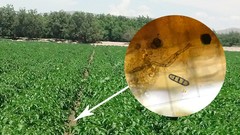
- Description
- Curriculum
- Notice
- Reviews
- Grade
Traditionally, agricultural practices have often relied on methods such as crop rotations, managed grazing, and the addition of compost and manure to maintain soil fertility and health. However, a newer approach known as microbial-based soil management is gaining attention for its remarkable benefits. This method emphasizes nurturing a thriving ecosystem of beneficial microbes within the soil, reducing the reliance on the constant application of commercial agrochemicals.
One of the key advantages of microbial-based soil management is the reduced need for external inputs like chemical fertilizers. Unlike conventional practices that require repeated application of agrochemicals, the focus here is on fostering healthy microbial populations. When soil biology is appropriately managed to support these microbes, it can lead to substantial cost savings for growers. Additionally, this approach has positive ripple effects on the environment, human health, and nutrition.
The presented course aims to equip growers and consultants with a cost-effective method to monitor and assess soil microbial communities. Designed for individuals at various scales of agriculture, the course provides practical skills to optimize production methods by harnessing the power of soil microbes. Although the course assumes a basic understanding of biology principles, its applicability extends to conventional and organic growers and diverse contexts like community gardening, turfgrass management, and soil restoration projects.
Ultimately, the principles of functional microbial food webs transcend different agricultural systems. By embracing microbial-based soil management, growers can unlock the potential of their soil ecosystems, leading to improved yields, environmental sustainability, and enhanced nutritional quality.
-
3Unit 1 - Why Microbes Matter, part A: A Few Thins Microbes Do
-
4Unit 1 QuizHow did we do? Answer these five questions to see how clearly my message is getting across! Don't know the answer? Replay the video as often as you like.
-
5Unit 1 - Why Microbes Matter, part B
-
6Unit 1 - Why Microbiomes Matter, part BQuiz for Unit 1, Part B
-
7Unit 2 - Why Perform Microbial Density and Diversity (MDD) Analysis?
After completing this section, you will be able to discuss both the benefits and the limitations of a Microbial Density and Diversity Analysis.
-
8Unit 2-Why Perform a Microbial Density and Diversity (MDD) Analysis?Unit 2 Quiz
-
9Unit 3 - Choosing Microscopes and Other Equipment
-
10Unit 3-Choosing Microscopes and Other Equipment, Part A
-
11Unit 4-Taking Informative Samples
In Unit 4 you will learn how to collect soil, compost, and compost tea samples that provide meaningful insights into the structure and function of associated microbial communities. Sample storage will also be discussed.
-
12Unit 4 Quiz-Taking Informative Samples
-
13Unit 5-Sample Preparation Protocol
In Unit 5 you will learn how to extract microbes from your soil sample, prepare a wet mount for analysis, and examine your slide under the microscope.
-
14Unit 5 Quiz-Sample Preparation Protocol
-
15Unit 6-Classification of Microbial Communities
In the previous five units, we have discussed how microbes can influence plant production, why microbial analysis can help guide management, the what tools you need to analyze microbes at home, how to collect and prepare your soil samples, and how to examine them under the microscope.
In unit six, we step back for a moment to look more deeply at the functions of microbial communities within various niches (plant surface, soil crust, rhizosphere, etc.) of the plant ecosystem. While this particular unit is more theoretical than applied, it is important to appreciate microbial community interactions before the value of having diverse representatives from the kingdoms we will examine in unit 7 become clear.
-
16Unit 6 Quiz-Classification of Microbial Communities
-
17Unit 7-Microbial Kingdoms You Want In Your Soil, Part A.
-
18Unit 7 Subunit A-An Overview of Biotic Kingdoms and DomainsTaxonomists are scientists that strive to classify living things based on similarities and differences. Because life and science are both constantly evolving, taxonomy has been changing ever since Carl Linnaeus proposed the binomial nomenclature system. In recent decades, the hierarchy of Domain has been placed above Kingdoms, and we have seen three Kingdoms divide into six. These changes are driven by new technologies that permit classification based on DNA sequence differences. In Unit 7A, you reviewed contemporary Domain and Kingdom classifications. We also discussed differences between eukaryotic and prokaryotic cells. Please answer the questions below to evaluate your understanding of the characteristics that define these categories.
-
19Unit 7 Subunit B-Measuring Microbes
One feature that helps you distinguish a deer from an elk, or a wolf from a fox, is the size. In the same manner, size is one of many characteristics you can use to distinguish among different kinds of microbes.
An optical reticle is strongly recommended, for ensuring more accurate measurements. Before you can use your reticle, you must calibrate each your objectives using an optical micrometer. In this unit, we will show you how that is done.
As you determine the distance represented by each unit in your reticle write this value on a label you can attach to your microscope. This will help you remember the value as you begin analyzing soil samples.
Because your reticle remains the same even as you switch objectives, you will need to calculate a unique value for each objective on your microscope.
Many microscope dealers offer excellent training on how to calibrate your objectives. Links to some of these additional resources are included.
-
20Unit 7B Quiz-Measuring MicrobesThe questions below will assess your understanding of how to calibrate your eyepiece reticle against your objective micrometer so that you can use your reticle to measure the microbes you observe under the microscope.
-
21Unit 7 Subunit C-Recognizing Living Cells and Identifying Prokaryotes
In subunit 7C, you will learn to distinguish living microbial cells from the mineral matter, organic debris, and other objects present in soil. You will also learn to recognize prokaryotic cells based on their size and shape.
-
22Unit 7 Subunit C-Recognizing Living Cells and Identifying Prokaryotes
-
23Unit 7-D Recognizing Eukaryotes
Learn the key features that distinguish each kingdom of eukaryotic cells (Protista (protists), Fungi, Plantae (plants), and Animalia (animals). Find online resources that can help you recognize protists and fungi.
-
24Unit 7 Subunit D-Recognizing EukaryotesReview distinguishing features of protists, fungi, plants, and animals
-
25Unit 8-Record Keeping Pt A-Soil Quality Estimates
If you are going through the trouble of collecting soil samples, it is worth your time to consider soil physical properties in addition to microbial diversity and abundance. In this subunit, you will learn how to estimate soil pH, texture, and humic acid content of your soil. The methods described here for are chosen for speed and ease of use in farm and garden environments. They are less precise than a laboratory analyses.
-
26Unit 8 Part A Quiz- Optional Soil Quality Estimates
-
27Unit 8-Record Keeping Pt. B Estimating Density and Diversity
Summarize and record observations of microbial density and diversity.
-
28Unit 8 Pt. C Minimizing Error, Keeping Records, and Interpreting Results
Learn how to minimize errors tied to your MDD Analysis. Consider features of rich microbial communities and organic amendments that buffer plant systems against change created by human error. Learn how to interpret results of your MDD Analysis.
-
29Unit 8 Part C Quiz
-
30Unit 8 Pt. D. Using Results to Guide Management
Learn two simple principles that help you apply your MDD Analysis results to management of high-yield, nutrient-dense crops, pest-resistant fruits and vegetables, beautiful gardens, and healthy landscapes.
-
31Unit 8 Part D Quiz
-
33Unit 9-Measuring Soil Respiration
Did you know soil breathes? Okay, it doesn't exactly inhale and exhale like you and I do. But the cellular respiration processes that convert sugars to carbon dioxide (CO2) are as essential to soil creatures as they are to you and I. This means soil microbes are constantly releasing CO2, kind of like you release CO2 when we breath. The amount of CO2 the soil releases can be used as a vital sign of sorts. If you stopped exhaling and releasing CO2, that would not be a good sign. The same is true for your soil. High levels of CO2 production suggest more healthy microbial cells are thriving in your soil.
In this unit, you will learn how to measure the amount of CO2 your soil produces with a do it yourself kit.
-
34Unit 9-Measuring Soil Respiration
Requirements
* Experience growing plants
* Note: You will need a microscope to implement what you learn. We will show you how to choose one that meets your needs.



